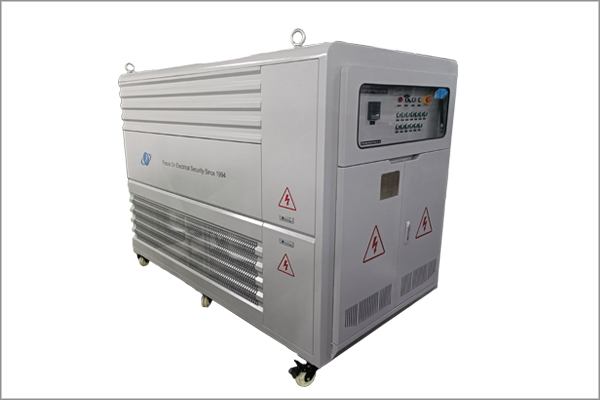In the fields of power systems, new energy equipment, industrial testing, etc., Load Bank is the core tool for verifying equipment performance and ensuring system stability. Its essence is to accurately test power supplies, generators, energy storage systems, etc., by simulating real load conditions. However, with the iteration of technical requirements, the load bank has gradually developed from a simple resistance simulation in the early days to a complex system with intelligent dynamic response capability. This technological evolution not only reflects the progress in the field of industrial testing, but also reflects the new requirements for equipment testing in the era of intelligence.

1000kW load bank
First, resistance simulation era: basic principles and limitations
The early load bank is based on the resistance load as the core, and its working principle is based on Ohm's law, through the resistance elements (such as metal resistance wire, ceramic resistance, etc.) to convert electrical energy into thermal energy consumption. This design is simple and reliable, and is suitable for the steady-state performance test of generators, UPS and other equipment.
Key technical features:
Pure resistive load: Only simulate the energy dissipation characteristics of resistive equipment (such as electric heaters), and cannot reproduce the dynamic characteristics of capacitive and inductive loads.
Manual adjustment: Switching resistance gears via physical switches or relays, slow response (seconds), accuracy limited by the discrete nature of the resistance element.
Heat dissipation challenges: During high-power testing, resistors generate huge heat, rely on air-cooled or water-cooled systems, high energy consumption and complex maintenance.
Limitations: It cannot meet the testing needs of modern power electronic equipment (such as frequency converters, energy storage converters) for dynamic loads (fast step, harmonic injection, etc.), and it is more difficult to adapt to high volatility scenarios in the field of new energy.
Second, electronic load stage: semiconductor technology breakthrough
In the 1990s, the maturity of power electronics technology gave birth to electronic load banks. Its core adopts semiconductor devices such as IGBT and MOSFET, and dynamically adjusts the equivalent impedance through PWM (pulse width modulation) technology to achieve more flexible load simulation.
Technological transition:
Diverse load types: It can simulate resistive, capacitive, inductive and nonlinear loads, supporting DC, AC and even high-frequency harmonic scenarios.
Improved dynamic response: The adjustment speed is shortened from the second level to the millisecond level to meet the test needs of motor start-up and grid transient fluctuations.
Digital control: Integrated PLC or embedded system, support preset load curve, remote control and data acquisition.
Typical applications:
Electric vehicle charging pile test: Simulate dynamic load changes during battery charging.
Efficiency verification of photovoltaic inverters: The effect of repeated light intensity fluctuations on output power.
Intelligent dynamic response: the integration of AI and edge computing
In recent years, new energy grid connection, microgrid, hydrogen energy and other emerging fields have put forward higher requirements for load testing - load banks need to have real-time perception, autonomous decision-making and predictive response capabilities. Therefore, intelligent dynamic response technology has become the core competitiveness of the new generation of load banks.
Key technological breakthroughs:
Adaptive algorithm: Through machine learning model, real-time analysis of the output characteristics of the device under test, dynamic adjustment of load parameters to match the real working conditions.
Case in point: In energy storage system testing, the load bank simulates frequency fluctuations in the grid and automatically optimizes charging and discharging strategies.
Edge computing architecture: The computing unit is deployed locally in the load bank to reduce the communication delay with the control host and achieve microsecond response.
Multi-source data fusion: Integrated temperature, humidity, vibration sensor data, combined with load test results for device health assessment.
Industry value:
Improve test efficiency: Reduce manual intervention and automate the test process for complex scenarios (such as scenery storage collaboration).
Risk warning: Use the device response data under abnormal load to predict potential faults (such as battery pack inconsistency).
Future trends: Evolution from "tools" to "systems"
The technical evolution of load bank is far from over. With the development of digital twins, 5G communications and the Internet of Energy, its role is changing from a single test tool to a key node in a smart energy system:
Cloud-edge collaboration: load bank data is uploaded to the cloud, and test solutions are optimized based on historical data, and cross-regional device collaborative testing is supported.
Virtual and real combination: Through the digital twin model, the load shock is previewed in the virtual environment, reducing the cost of physical testing.
Green design: Waste heat recovery, efficient topology and other technologies to reduce energy waste during testing.
Conclusion
From resistance simulation to intelligent dynamic response, the technical evolution of load banks is not only the upgrade of hardware and software, but also the innovation of industrial test concepts - from "passive simulation" to "active adaptation", from "single function" to "system empowerment". In the future, with the superposition of intelligent and low-carbon needs, the load bank will continue to break through the boundary and become an indispensable "smart chemist" in the energy revolution.
 2024-09-11
2024-09-11 2023-04-21
2023-04-21 2023-04-06
2023-04-06 2022-05-05
2022-05-05 2022-05-05
2022-05-05

